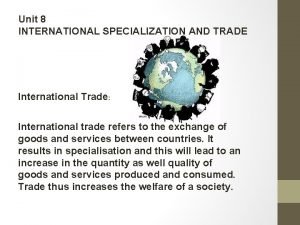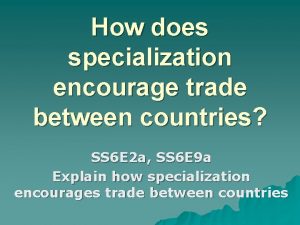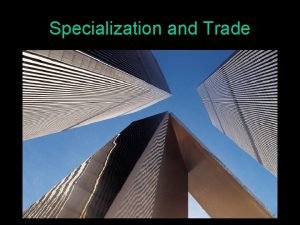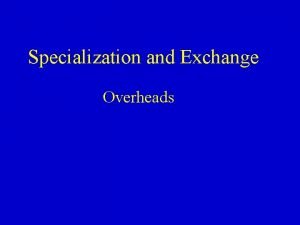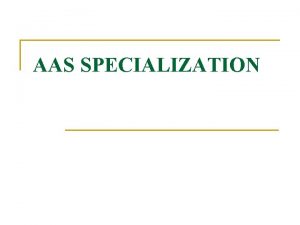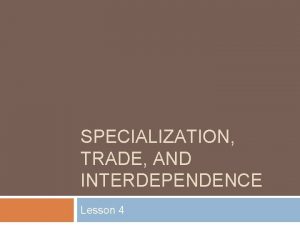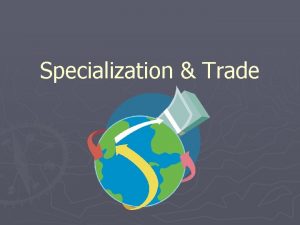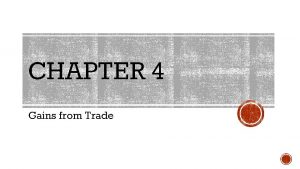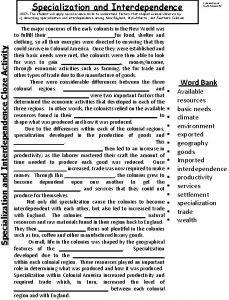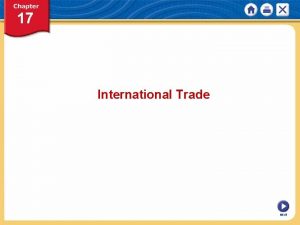Specialization and Trade Specialization Do what you do












- Slides: 12

Specialization and Trade

Specialization “Do what you do best; trade for the rest!” • Attempting to produce everything you want to consume yourself limits both your production and consumption possibilities. • To specialize, you must figure out what you “do best. ” Economists define “best” as that which you produce at the lowest opportunity cost. • • “Trading for the rest” by “selling” the goods or services you can produce at low opportunity costs and then “buying” things you would produce at a high opportunity cost requires division of labor. Specialization and trading goods and services with others can help everyone.

Specialization • Specialization encourages trade and can be a positive factor in a country’s economy. Specialization occurs when one nation can produce a good or service at a lower opportunity cost than another nation. • Sometimes, specialization has not functioned as expected. What are the potential problems of over-specialization such as one-crop economies and lack of diversification? How can this impact a region’s economy?

Currency Exchange • Before people from different countries can buy or sell anything to each other, they have to solve a basic problem. • Buyers have to be able to change their money from their country's currency to the seller's national currency. This is called "foreign exchange. " • Each currency, whether it's the US dollar or the Haitian gourde, has a value in terms of other currencies. This is the "exchange rate. " • Without a reliable supply of foreign exchange in each country, and without relatively stable exchange rates, world trade would drop drastically. • You wouldn't be wearing tennis shoes made in Asia, or eating an apple grown in New Zealand.

Exchange rates • Exchange rates provide a procedure for determining the value of one country’s currency in terms of another country’s currency. • Without a system for exchanging currencies, it would be very difficult to conduct international trade.

Barriers to Trade • A tariff is a tax placed on goods that one nation imports from another. • Many nations use tariffs to protect their industries from foreign competition. • Tariffs provide protection by acting to raise the price of imported goods. • Thus, tariffs encourage domestic firms to increase their production, and consumers are forced to pay higher prices for the protected goods.

Import quotas • Import quotas offer another means of protectionism. • These quotas set a limit on the amount of certain goods that can be imported into a country and tend to be more effective than protective tariffs, which do not always stop consumers who are willing to pay a higher price for an imported good.

Embargo • An embargo is an order designed to stop the movement of goods. • An embargo, issued by the government of one country, may restrict or suspend trade between that country and another nation. • A government may impose an embargo to hamper the military efforts of another government. • For example, the United States prohibits the export of weapons to countries that sponsor terrorism. • Sometimes a government imposes an embargo to express its disapproval of actions taken by another government. The embargo is intended to pressure the offending government to change its actions.

How do Economies Grow? Factors of Production • There are four factors - land, labor, capital, entrepreneurship - that influence economic growth. • Capital is split into two categories: human and physical. • Economic growth is usually measured by calculating the percent increase in GDP from one year to the next. This is known as the GDP Growth Rate.

How do Economies Grow? Resources that influence economic growth • Land provides the basic raw materials-vegetation, animals, minerals, fossil fuels--that are inputs into the production of goods (natural resources). • Labor is the resource that does the "hands on" work of transforming raw materials into goods. • Capital is the comprehensive term for the vast array of tools, equipment, buildings, and vehicles used in production. • Entrepreneurship is the resource that undertakes the risk of bringing the other resources together and initiating the production process. • LAND: This category sometimes extends over all natural resources. It is intended to represent the contribution to production of nonhuman resources as found in their original, unimproved form. A material source of wealth, such as timber, fresh water, or a mineral deposit, that occurs in a natural state and has economic value • LABOR: human effort used in production which also includes technical and marketing expertise

How do Economies Grow? Resources that influence economic growth • CAPITAL RESOURCES: humanmade goods which are used in the production of other goods. These include machinery, tools, factories and other buildings, and technology. • HUMAN CAPITAL – education and training of workers whether formal or on-the-job • ENTREPRENEURSHIP: Entrepreneurship is a special sort of human effort that takes on the risk of bringing labor, capital, and land together and organizing production. Entrepreneurs combine the other factors of production, land, labor, and capital in an innovative way to make a profit.

Investment and GDP • Investment in improving a nation's capital resources and/or human capital results in economic growth and improved GDP. • Failure to improve these types of capital, or the inability to improve them results in no growth of GDP. • Nations which have valuable minerals such as diamonds, gold, uranium, and/or petroleum can profit from the income that the extraction and sale of these minerals, which will increase the national GDP. • Sometimes this money is stolen by corrupt leaders, but when the income is used to improve the nation's infrastructure, the citizens may benefit. • Highly developed economies like the USA and Israel have smaller growth rates because the size of these economies are already so large.
 International specialization and trade
International specialization and trade Comparative advantage exists when one person can produce
Comparative advantage exists when one person can produce How does specialization encourage trade
How does specialization encourage trade How does specialization encourage trade
How does specialization encourage trade Trade diversion and trade creation
Trade diversion and trade creation Umich
Umich Which is the most enduring free trade area in the world?
Which is the most enduring free trade area in the world? Trade diversion and trade creation
Trade diversion and trade creation Types of tramp chartering
Types of tramp chartering The trade in the trade-to-gdp ratio
The trade in the trade-to-gdp ratio Fair trade not free trade
Fair trade not free trade Ted talk slave trade
Ted talk slave trade Tell me what you eat and i shall tell you what you are
Tell me what you eat and i shall tell you what you are
